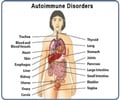A protein that could open fresh possibilities of understanding both APS-1, the rare hereditary disease where the immune system attacks the body’s own organs, and other autoimmune disorders.
Scientists working on a major EU project, coordinated by Professor Olle Kämpe at Uppsala University, have identified a protein that could open fresh possibilities of understanding both APS-1, the rare hereditary disease where the immune system attacks the body’s own organs, and other autoimmune disorders. The findings are published in the American journal The New England Journal of Medicine.
The newly discovered protein, which goes by the name of NALP5, constitutes the target for the immune system’s attacks on the parathyroid glands in the disease APS-1. This finding enables researchers to more closely study the first phase of autoimmune disorders in general, where immune cells, instead of attacking alien bacteria and viruses, erroneously attack the body’s own tissue.The protein functions as a target for the immune cells in humans, but also in animal models for the disease that have the same genetic defect as APS-1 patients.
“This means now, for the first time, in an experimental situation we will be able to compare the immune defense with exactly the same target protein in humans and in an animal model,” says Mohammad AliMohammadi at the Department of Medical Sciences, Uppsala University, who made the discovery.
The parathyroid glands are the most recently described anatomical structures in humans. They were discovered in 1879 by scientists at Uppsala University and regulate the body’s calcium balance. The fact that the protein NALP5 was found in the parathyroid glands enhances our understanding of their functions. In the long run this discovery can make it possible to develop drugs and treatment methods for diseases producing disturbances in the calcium balance, such as osteoporosis.
In patients with APS-1 the parathyroid glands can be knocked out at a very young age, which can lead to severe cramp attacks that regular cramp treatment is powerless to alleviate. If the disease is not discovered, it therefore often leads to death. The new discovery also makes it possible to diagnose the disease early, so that patients can receive the appropriate treatment.
Source-Eurekalert
THK/L











